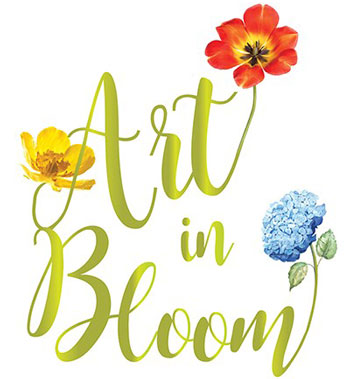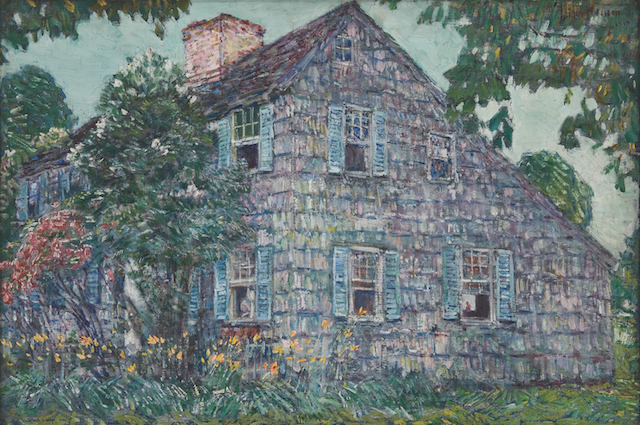BY GRACE MCQUADE
“Art, to me, is the interpretation of the impression which nature makes upon the eye and brain,” American Impressionist painter Childe Hassam once said, adding that “true Impressionism is realism.”
Hassam, who was instrumental in spreading Impressionism in America during the early part of the 20th century, is one of more than 50 artists included in the exhibition, In a New Light: American Impressionism 1870-1940, Works from the Bank of America Collection, on view at the Heckscher Museum of Art from May 25 to Aug. 18.
The exhibit is part of Bank of America’s Art in Our Communities program, the company’s ongoing effort to support the arts and bring them to local communities.
“The exhibitions are organized from the company’s extensive corporate art collection and they lend these exhibitions out to museums and nonprofit galleries worldwide,” said Kerrilyn Blee, curatorial assistant at the Heckscher Museum, during a recent phone interview. “It’s a big program for them, and we’re excited to be a part of it.”
Of the 130 artworks that were included in the original show, Heckscher will have 61 pieces in their exhibition that will be displayed throughout the museum.
“We have four galleries in the museum. This show is going to take up three and that’s only because it comes in such large crates that we have to use one of our galleries for storage,” Blee said. “It’s going to be the only show in the museum at the time, which we haven’t done in over 10 years… We’re really excited to have it as our main attraction.”
As visitors enter the museum, Blee says they will see two exhibit artworks in the lobby, Charles Adams Platt’s landscape painting, “Orchard, East Hampton,” and Lawton Silas Parker’s portrait, “First Born.”
“The exhibition is designed to follow the development of Impressionism in the United States,” Blee said. “So in the south gallery, where the exhibition begins, we start with the Hudson River School and Tonalist works. In the north galleries are the majority of the Impressionist works by artists from art colonies and locales across the country, presenting their diverse interests and varied interpretations of Impressionism in urban, maritime and rural settings in America.”
While explaining this artistic evolution, Blee said that the Hudson River School wasn’t actually a school, but a group of artists, mainly based in New York City, who travelled throughout the Hudson River Valley, creating on-the-spot sketches.
“They would take these sketches back home and make these idealized, majestic landscapes,” she said. “Whereas when American Impressionism came about it was much more realistic, much more capturing the landscape in the moment… (It) was a reaction to the Hudson River School, kind of like going against it… The artists who were interested in Impressionism wanted to do something different.”
Blee went on to describe how many of these artists traveled to Europe to learn from the French Impressionists. Although American collectors initially rejected this art form, they eventually came to appreciate how American Impressionists depicted local landscapes and architecture.
“The exhibit shows how American Impressionism differs from French Impressionism because it was uniquely American,” Blee said. “Although they were similarly interested in capturing specific moments in time and scenes of everyday life as the French Impressionists were, they wanted to alternatively capture places that communicated a sense of national identity.”
One example in the exhibition is Colin Campbell Cooper’s “West Front of the Capitol Steps, Washington, D.C.,” which Blee says exemplifies “that sense of nationalism and pride.”
The exhibit includes another locally-inspired painting, Hassam’s “Old House, East Hampton,” Long Island artist Thomas Moran’s “View of Fairmount Waterworks, Philadelphia,” and other works derived from artist colonies that formed in Connecticut, Massachusetts and throughout New England during this time.
Long Island’s main artist colony back then was in Shinnecock. “That’s where a lot of the artists, including Hassam, traveled back and forth to,” Blee said. “They all wanted to experience the different landscapes so it was very common for them to travel to the different art colonies on the east coast.”

Each floral arrangement will be displayed on a 36-inch-high pedestal near the painting that served as its inspiration. “We’re really excited to see what they come up with,” Blee said. Garden club docents will be in the galleries on these days, from 1 to 3 p.m., to discuss the arrangements and design process.
On the 9th, from 2 to 2:30 p.m., visitors can watch floral design come to life as new members and volunteers from each garden club participate in a challenge class to create two original designs inspired by the identical flowers and materials they receive at the start time.
Blee says the half-hour challenge, similar to a cook-off competition, will be fun and interactive. The final arrangements will be raffled off to two lucky visitors to take home.
Pamela Sherlock, president of the Three Harbors Garden Club, is pleased to participate in the inaugural Art in Bloom. “We really see this as a special opportunity, obviously to support Heckscher and introduce members to this local gem that we have, while educating and challenging ourselves,” she said.
Each garden club will create five designs — four of their own choosing and one selected by the museum — drawing from 10 paintings in the exhibit. “For all the designers, it’s the best you can hope for in terms of the type of artwork to inspire us so we’re really excited,” Sherlock said.
The Three Harbors Garden Club will take a team approach in the creation of their five pieces. “We have five lead designers, one for each of the paintings,” Sherlock said, but “we’re bringing in other members who are new to exhibiting so they can be a part of the process as we create our designs.”
Group input is important to Sherlock because, she said, “Most of us have exhibited maybe at a club show, or maybe through GCA shows or through events at our churches, but this will be the first time in a museum so we’re really challenging ourselves to take this to the next level.”
Sherlock said there will be a range in their fresh and dried materials, “whether they be flowers that are cut from the garden in June or exotics,” as well in their designs.
“To give you an idea, we’ll have some that will interpret urban states,” she said, referencing Theresa Bernstein’s “Armistice Day, The New York Public Library.” “As you can imagine, that might be very different from ‘Snow’s Freedom’ by Antonio Cirino, which is a very woodsy, river brook natural landscape interpretation.”
Jane White, the floral design chair for North Country Garden Club, said that their five arrangements, each with two designers, will also vary depending on the artwork and artists’ inspirations.
“For instance, in the ‘Green Mansions’ painting by Daniel Garber, the designers have looked at this in kind of that ‘Great Gatsby’ feeling of an ornate vintage container with bursts of greenery on top,” she said.
In “Connecticut Trout Stream” by Ernest Lawson, White said their artists’ intent is to “reflect the stream with strong white snow star masterwort, a type of flower, in the center of the design,” along with “blue thistle, japonica greens, Devil’s Blush and yellow Gerber daisies to reflect the warm yellows and reds and cool greens and blues of the woods.”
White is particularly excited about interpreting Gifford Beal’s “Garden Beach,” “which is just a profusion of colors,” she says. “I think the designers are going to use lines, shapes, patterns, positive and negative spaces to interpret the colorful impact of that painting.”
When discussing their design plans, both Sherlock and White drew parallels between the artistic endeavors of painting and floral design.
White said the question that keeps coming up on her end is whether it’s more challenging to draw inspiration from another’s work or create something freestyle, perhaps an age-old debate amongst artists.
For Sherlock, it’s the recognition that when it comes to art, beauty is in the eye of the beholder and its lasting “impression.”
For more information about In a New Light and Art in Bloom, contact the Heckscher Museum at 631-351-3213 or go to www.heckscher.org. The museum is located at 2 Prime Ave. in Huntington.



